

Déjà vu is when you get the strange feeling that you might have done something before ... and our story starts with a specific request to test a Honda People cyclemotor.
At only 24cc, this is the smallest capacity motorised transport that Honda ever made ... the problem is, they never sold any in Britain and, as far as we know, there aren't any here ... so who might we know with one of these?
Our feeling of déjà vu begins on Friday 16th December 2011, with a drive down to London to catch flight NZ001 leaving Heathrow at 4:30pm for Los Angeles. Eleven hours later our Boeing 777 lands at LAX, 7pm local time, still on 16th December (now 3am UK time).
There's a 2½ hour service stop and, though nobody even gets to put a foot on American soil, the US security take an hour to fingerprint and photograph every passenger, just for the sake of spending the remaining time in a first floor transit lounge only 50 yards from the plane. The flight resumes, taking off again at 9:30pm West Coast local time, still on 16th December (5.30am UK time), for another 12½ hour flight, landing at Auckland, New Zealand at 7am local time (6pm UK time) on Sunday 18th December.
With the sun setting back in the UK when we first took off in the evening, the entire journey is travelled in 26 hours of continual darkness as the flight follows the rotation of the Earth. Having taken off from Heathrow at 4:30pm on the 16th December 2011, we somehow seemed to have managed a 42 hour Friday, but skipped Saturday completely by crossing the international dateline on the approach to New Zealand.
If it seems difficult getting your head round how this time travel thing works, it's certainly no clearer when you actually do it!

Picking up a car in Auckland, it's then just a few hours drive out past Te Puke, to Pongakawa, where our test machine is waiting for us.
It seems that the Honda People cyclemotor is not a common machine in New Zealand either; the Blue Wing Honda dealers here tell us that only four sample machines came into the country in 1986, so we're very lucky to find one at all!
Having a little look though the technical specification prior to the main event might give us some grasp of what we're dealing with here... Oh great! The manual that comes with the bike is only in Japanese!
Never mind, let's see what we can glean from it anyway.
Honda People model designation is PY25D of 24cc, being an air-cooled two-stroke with crankcase induction, single reed-valve engine of 32mm bore × 30mm stroke, rated 0.7bhp @ 4,000rpm.
Looking at the single-speed automatic engine from the left hand side, anyone could be forgiven for thinking the motor might be fan-cooled, since the screw fitted plastic air filter cover is very similarly shaped to resemble draft ducting.
The bike appears physically quite small, the frame apparently based on a small lady's cycle, with 24×1.75 wheels & tyres, and dainty little hub brakes at both ends.
The dual-sided fuel tank is divided, two-thirds to the right for neat petrol, and one-third to the left side for poziforce oil. Standard equipment includes front and rear carriers, a rear stand, a prop stand, and a basic tool kit comprising a two-way screwdriver and plug-spanner set in a small bag behind the saddle.
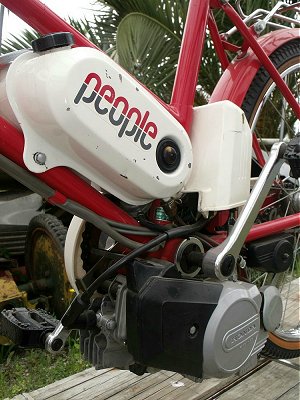
Even on this smallest Honda, a complete electrical set is a factory fitment, with front and rear lamps, a flashing indicator set and electric horn.
The plastic moulded pedal chain guard appears remarkably similar to the Honda P50 from the mid 1960s, but it's rather doubtful that Honda recycled the old tooling since it's not really the way they do things.
Engine control requires a little investigation to figure what's going on. There's a double trigger mechanism on the right handlebar, the red lever being stiff to operate since this pulls the engine off drive against a spring but, when disengaged, holds it against a latch so you can ride the machine exactly like a bicycle. Operating the red lever to disengage the drive roller automatically cuts the ignition, so it's not normally possible to run the motor off-drive. The yellow trigger below proves to be the throttle lever, thumb forward to open up, which instantly releases the red latch to re-engage the drive.
There doesn't appear to be any fuel tap, so we conclude that any flow valve will be vacuum operated. Neither, it seems, is there a manual choke control so presumably this function is similarly automatically effected. Fairly untypically for Honda, however, there appears no switchable ignition, lock or key. Though this did tend to be a standard characteristic of the company's old basic moped models of the '60s and '70s, it does strike as a somewhat unexpected absence for a machine from the 1980s.
Operation pretty much comes down to just pedalling People away like a bicycle, then triggering in the drive by thumbing the throttle lever. Keep pedalling since the engine turns over straight away, clanking ominously as crank rotation is seemingly being driven by a pawl but, once started, the motor runs quietly and smoothly with no more than a muffled phuttering. The automatic choking mechanism is clearly engaged in this early phase, since the engine steadfastly refuses to be hurried by the throttle and simply dies right out upon any attempt to tweak on the lever. The motor absolutely meeds to warm-up sufficiently and disengage the choke in its own good time before you can even consider operation in any effective manner.
The surprising thing is that when the motor is running, choked or not, there is no discernable smoke or fumes that smell. Put your palm near the tailpipe and you feel little more than a gentle air pulse but there's no real perception this could be produced by any internal combustion engine.
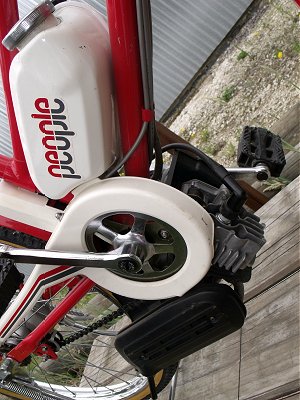
From engine tick over, thumbing the throttle lever raises the revs to engage the automatic clutch - which is pretty much the point where you begin to wonder if something might not be working properly. People just crawls along at a gentle cycling pace, that's it, that's all it does. It's feels as if something may be wrong with the engine ... is the fuel getting through, yes, that's fine ... is the carb clear, yeah spotless ... plug/ignition, yep, all perfect ... we checked absolutely everything and, no, there really seems nothing at all wrong with the bike in any way.
OK, so let's run it up the road and clock what it's actually doing along the flat with the radar gun ... 15km/h ... so let's go back to the Japanese manual and see if we can find what the quoted performance might be in the specification section ... oh yes, look, that'll be it: 15km/h! That's what? 9mph? And we've just travelled 13,000 miles to test a cyclemotor that only does 9mph!
Undeterred, we take the People out for another full throttle run ... crouched this time, downhill, maximum thrash ... 18km/h on the radar gun. Nearly 11mph. Hah, that showed Mr Honda!
There was a brief rain shower during our test, and nearly a dramatic moment when the rear tyre picked up a spray of water, causing a little squeal of excitement from the rubber faced drive roller ... no, we're clutching at straws now, the People really was utterly pathetic, deadly dull, what a load of rubbish!
Some of the old marketing blurb says "The People will climb any hill without the need to pedal" - no it won't at all, it hasn't got the power to tear its way out of a wet paper bag, it's useless!
The only conditions People felt as if it could cope with, was riding around the indoor workshops in still air, on a dead flat and smooth concrete floor. Take it outside into the big wide world, a little breeze, a surfaced road, a few inclines, and it's just completely lost.
The tiny engine runs so quietly that you're barely aware that it's going at all. Since you can't really hear the engine doing anything, and since its performance is so far below all expectation of what any motorised cycle should achieve, the generally perception of anyone riding People out on the open road, is that its capability falls badly short.
The expectation gap is too great between what a motorised bike should achieve, and the feeble limitations of what People is actually capable of. You can easily pedal the bike faster than the engine will propel it, so what's the point of having such an inadequate machine?
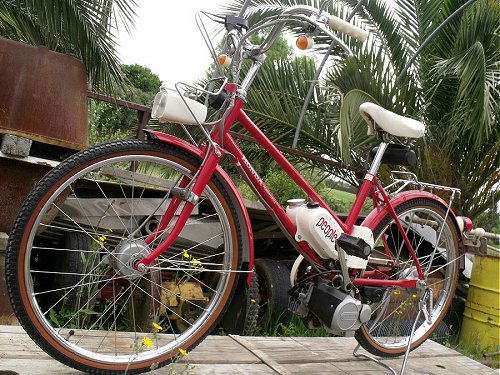
We can only imagine that its intended purpose was for indoor use, riding around inside covered shopping malls!
Any rider is fairly naturally going to base any impression of a motorised bicycle against the performance of a moped, but People falls so far below any normal expectation that it feels like it isn't even working properly!
Considering People's miserable performance, any observation about braking proving more effective than you could ever possibly need should be barely worthy of the comment.
The area ahead of the handlebar set is fairly cluttered with a jungle of cables, sheathing and wires though there is no battery in the electrical circuit, with the system operating solely from the flywheel generator set. When we try the lights they prove really bright at both front and rear, so the dazzling headlamp beam is by far the fastest thing on the bike at 186,000 miles per second.
A dual function switch on the left handlebar switches the direction indicators to flash left or right while accompanying it with soft electronic novelty bird tweeting in time with the blinks, but pushing the horn button generates a startling electronic scream.
The Blue Wing importers were so dismayed with the hopeless performance of their four sample bikes they didn't want to order any more.
Since the People was so wholly inadequate for any purpose that anyone may have wanted to ride one for, the New Zealand sample bikes were never really used for anything and, 25 years later, still remain in perfect original condition, unwanted by anyone and as useless as the day they arrived.
It seems that the Honda People cyclemotor must have been a complete failure. It's inconceivable that anyone would want to buy such a machine since it would be completely inadequate for anyone's needs in the western world ... but that's not quite the end of this story...
Our return trip starts on 10th January 2012 from near the bottom of the South Island, setting off from Dunedin at 10am, driving to earthquake shattered Christchurch where we drop the car at 5pm, then wait for our internal connecting flight NZ302 at 8:30pm. Arriving in Auckland at 9:30pm, there's another wait to catch international flight NZ039 taking off at midnight to Hong Kong, where we land at 6am on 11th January after an 11 hour flight through the night.
Following a 3 hour transit stop, during which the sun rises, our journey resumes at 9am local time, for a further 13 hour flight to London Heathrow, where we touchdown at 2pm, still on 11th January.
Due to following round the rotation of the Earth, our daylight period lasted some 21 hours, and seemed to make this around a 38 hour day. We've now travelled right round the planet, 26,000 miles, on this particular mission ... but there's more...
If you've got an old model that's gone obsolete and nobody seems to want, what do you do with it?
Of course ... you license the design to the Third World and, perhaps, someone would make it in ... China maybe?
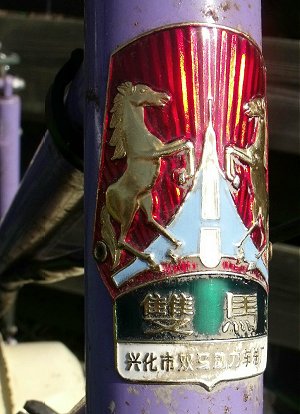
Fortunately, we're lucky enough not to have to go to China for the second part of this feature ... all we have to do now is drive to Horham on the Suffolk county border to test our comparison machine, and there's something slightly familiar about the 24cc Shuang Ma cyclemotor...
Just have a look around the bike, and it's fairly easy to appreciate the Shuang Ma is sort of the same, but different.
The People motor is quite recognisable, but instead of Honda badging, the transmission case is cast with "RCNRJ" initials and, no, we don't know anything about who actually made this engine in China, we've been unable to trace anything! Similarly, we've also been unable to trace anything about Shuang Ma either, so any background on this contraption is really a bit of a mystery.
At first glance, you'd almost think the cyclemotor had been simply bolted onto this Shuang Ma bicycle, and might theoretically have been sold as an attachment motor for bolting onto any other bicycle, just like in the good old days of cyclemotoring - but look closer, and you can soon appreciate there's more to this than a cursory glance reveals.
A special engine mounting is welded below the bottom bracket, then behind and above the bottom bracket are further fittings welded onto the frame for mounting the HT coil and associated components, and there's a special bracket welded to the swing-arm for connecting the motor engagement mechanism.
There's soon a realisation that you simply couldn't bolt this engine to any other bicycle frame in the manner of the old time cyclemotors. Shuang Ma is a specially constructed complete and individual machine in its own right, just as much as the original Honda People was in the first place.
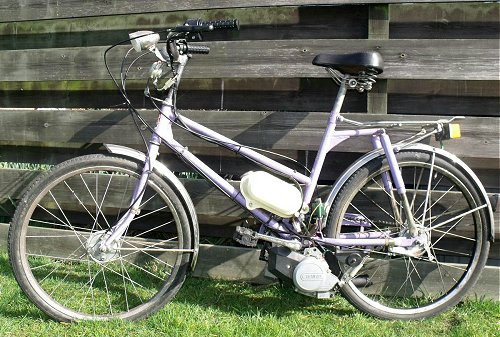
Having established that the Shuang Ma frame is specifically made to mount the RCNRJ engine, it's interesting to study the rest of the bike with this in mind.
Wheels and tyres are sized 24×1.75 with an 18-inch frame, much the same as the Honda People, but everything is adjusted to taller settings, so the cycle doesn't feel quite so diminutive.
With its bright metallic colours, the headstock badge is a particularly eye-catching and fascinating example of communist patriotic artwork. There are two rearing stallions facing toward some sort of classic V-wing plane? Or is that a space ship ... maybe some sort of missile? All very inspiring stuff!
The translation of Shuang Ma means "double horse", so it's now clear how the bike's name relates to the logo.
Chinese graphics along the lilac painted main frame tubes interrupted by 'Shuang Ma' in western lettering probably suggest the machine was also intended for export markets, but the "Euro Bike" graphic printed on the top frame tube looks almost like a John Bull Printing Set, ink and stamp addition.
The 'Stallion' logo further compliments the frame lettering, and even appears printed onto the rear light lens!
Starting Shuang Ma has a little more 'manual' involvement than the People.
There's the same People petrol tank, with the same 2/3+1/3 sided pressings, but there's only a single cap in the right hand side with no separate pozi-force oil reservoir, so this machine runs on old-fashioned style pre-mix fuel.

There's a fuel tap at bottom left of the tank, then what looks like a second fuel tap just below and behind it? This 'second tap' is apparently the choke, and seems to serve as a sort of manual control replacing the automatic thermal choke from the original Honda arrangement. Opening the choke-tap seems to act like some enrichment valve and draw extra fuel for starting.
Fitted on the left handlebar, is a typical light motor cycle control cluster with rear brake lever, light switch, horn button and left/right turn indicator control.
Atop the conventional twist-throttle and front brake lever on the right handlebar, is a third lever control marked with familiar choke open/closed symbols but, as we already know, this actually has nothing to do with the choke, so we investigate the mechanism to see what it really does.
The lever seems engaged in the 'O' position and doesn't enable any change until you press a small red button on the front of the control, at which poiny, the lever springs back into the marked 'choke' position. Down at the other end of its control cable, the engine has moved to engage the roller drive, then switching the lever back to 'O' again disengages the motor and returns the machine to cycle mode.
The throttle control and front brake lever look like typical light motor cycle fittings, but the choke-cum-engagement control almost appears to be something adapted from some lawnmower maybe? We imagine this choke-cum-engagement mechanism to be a genuine original fitment since it's an integral part of the control assembly, but use of the choke symbols might seem a little confusing?
The rectangular rear lamp cluster has a red central lens printed with the stallion logo, and left/right orange indicator lenses to either side, while a bare mounting bracket on the handlebar stem suggests the possibility that a similar indicator cluster may have been mounted on the front at some time.
To fire up the engine, just engage the drive and pedal away. As the motor spins, there's an ominous clanking as crank rotation is driven by a starting pawl in exactly the same manner as the original Honda but, once started, the motor runs quietly and smoothly with little more than a muffled phuttering.
The choking control needs to remain switched on in this early phase, since the engine steadfastly refuses to be hurried by the throttle and tends to die out upon any attempt to prematurely disengage the choke-tap. Attempts to ride the bike on the engine with the choke engaged only result in the engine cutting out when the twistgrip throttle is opened, so the motor really needs to run for a while before it generates enough heat to switch off the choke and run clear on the throttle.
This characteristic warm-up behaviour very much mirrors Honda People's automatic choking phase, but Shuang Ma's operation is totally manual.
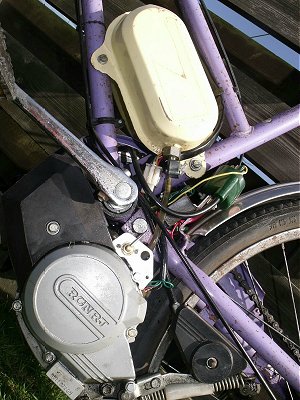
There's a fair smoky presence emanating from the end of the silencer, so seemingly not as clean-burning as Honda's People, but then we also don't know what type of oil or pre-mixture fuel is going through the system, so maybe best to reserve judgement on this matter.
Opening the throttle to raise the revs engages the automatic clutch, and the RCNRJ engine seems surprisingly capable of pulling away under its own steam! This doesn't at all relate to the Honda, which couldn't drag the skin off a cold rice pudding!
Shuang Ma reasonably accelerates up to a comfortable cruising speed around 12mph, at which the motor is humming along busily but not over exerting itself. Wind the throttle right up, and our pace bike reads off 15mph along the flat, then duck into a crouch, downhill, maximum thrash ... 18mph by the pace bike. A clear 7mph faster than the People... Hah, well that shows Mr Honda how it should really be done!
The motor was certainly revving quite furiously at top speed, and it'd be a merciless rider who tried to maintain such a pace for anything other than a flash reading. Returning to base and parking up, Shuang Ma's motor and exhaust were steaming hot, but the difference was that this RCNRJ engine could actually achieve some performance, while the Honda most certainly could not.
Shuang Ma's exhaust tone becomes quite noisy and harsh at speed, notably much louder than the People, so the silencer obviously doesn't contain the experience of Honda's baffling technology. As the snarling exhaust noise precedes the bike, you become aware that pedestrians are alerted and invariably look round expecting some larger machine to be fast bearing down upon them, followed by a slightly puzzled expression when they can't see anything, then amusement when they realise there is actually no threat - and all the racket is being made by an odd and slow moving bicycle!
Never mind, the rider can exact some revenge for pedestrian scorn by pressing the horn at the last moment, which produces an unexpected and blistering shriek, much louder than might be presumed from something that appears so much like a bicycle - that makes them jump! Shuang Ma has the last word after all.
The tiny headlamp generated a dazzling white glare, though the taillight seemed more reasonably subdued. The rear indicators blinked silently, the hub brakes were adequate, and the ride proved comfortable enough within the machine's capability.
Frantic pedalling of the cycle could just about achieve a slightly faster speed than the engine, so the drive ratios were reasonably selected for the rider to assist the motor if required, but without the danger of forcing it to over-rev if the pedal ratio was any higher.
Shuang Ma's moulded saddle has a peculiar construction, since it feels rather as if it is softly inflated, but a look underneath reveals it to comprise a foam composite with plastic top. The seat actually proved very comfortable, which was probably just as well, since the rear suspension units were so over sprung that you could barely encourage any movement out of them at all. The rear springing was literally so hard that you really had to wonder why they went to the involvement of putting it on?
Up front, the rigid cycle fork was obviously totally unforgiving, so most effective suspension came from the tyres, but overall the ride proved quite satisfactory and within the expected capabilities of the machine.
Our Shuang Ma spent a lot of its time inside and outside the workshops, just leaning around ... because it hasn't got any stand. Whether it was supplied 'standless' or lost it along the way, we don't know, but it's another notable contrast to the People which had two stands!
For a while we were left wondering if the RCNRJ engine was an officially licensed design from Honda, or another example of a pirate copy that often seems to be case with so many Chinese products - then IceniCAM was contacted from Canada with the report and pictures of another Shuang Ma cyclemotor! This example differed in a number of details, with the cycle frame fitted with a telescopic fork set, and the motor logo plate appearing completely blank. Since the engine casing seemed to be blanked by a plug to blind out where the pozi-force oil pump had been deleted in favour of a return to pre-mix fuel, the conclusion was these casings represented castings from the original Honda People tooling, genuinely transferred to a Chinese manufacturer.
The Honda emblem seemed to have been ground from the motor logo plate, so initial Chinese engine castings appeared blank, before the RCNRJ letterset was subsequently added to the tooling. Our presumption is that the Canadian Shuang Ma pre-dates our 'Eurobike' test machine, and the Chinese manufactured Shuang Ma was an officially licensed product from Honda using the same engine tooling as the People.
Whatever the answer, the Shuang Ma certainly went appreciably better than the original Honda People, which only performed exactly as it was designed to do. Since we've been unable to trace any references to either the Shuang Ma, or its RCNRJ engine, we can't really suggest from when-to-when it might have been made, but seems pretty clear that it's no longer in production today.
Next - From time to time we've managed to cover the occasional mini-scooter, since these machines still fall within our general 'under 100cc' brief. A little variety is always good, and the scooter theme has come round its orbit again for another eclipse. This time, from the very cradle of the modern scooter, we're getting set to present a feature on this small and particularly obscure Italian mini-scoot that arrived rather "Late for the party".
Want a clue? OK, it's a La... - no, surely you can't expect us to give it away as simply as that? And if you're pretty sure it might be from the clue - the guess is probably going to be completely wrong!
This article appeared in the July 2012 Iceni CAM
Magazine.
[Text and photos © 2012
M Daniels.]
You might say that the Honda People feature came about as a result of the first IceniCAM research team visit to New Zealand over Christmas and New Year 2009/2010, when Danny was photographing the Kelven Martin collection near Te Puke, and included a couple of snaps of Honda's smallest motorised vehicle among this "world photo's" sequence.
Back in Britain, we'd never encountered this machine at all, which created some interest. Then, subsequently, more so when David Whatling turned up at the East Anglian Run on his Shuang Ma cyclemotor and a startling similarity was suddenly appreciated!
With another story calling, the research team was despatched on another round-the-world trip over Christmas and New Year 2011/2012 to investigate the littlest Honda, but was far from impressed by a 26,000 mile round trip, primarily to test a miserable 15kph (9mph) cyclemotor.
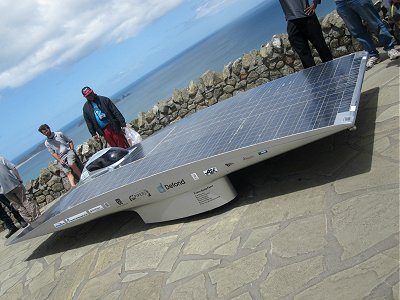
Fortunately there were opportunities to test several other machines along the way, so the research expedition returned with a lot of other useful material as well.
Many of the various test notes were worked up into draft blocks at practically any opportunity during the course of the travelling, like crossing the Cook Straight between Wellington and Picton on the InterIslander ferry - it's important to seize every chance to record details as soon as possible before things get forgotten.
A People Power text file began developing shortly after return when the notes were typed up; then the Shuang Ma was collected for analysis in March, but got slightly held up by the 'drought' when it rained every day we tried to do the road test and photoshoot!
With a block of three New Zealand based features rapidly evolving, it was decided to target their publication together as a special antipodean edition of IceniCAM 22 for July 2012, so all the intros were dropped into the ends of the IceniCAM 21 articles in April 2012. Now the deadline was committed.
Taking all the draft texts to Cyprus in early May, Danny mainly worked up the notes at the villa in Agios Georgios over the following week, so most of the files were completed by his return in mid-May.
Escaping from all the constant calls, mail, and day-to-day business, Cyprus 2012 proved a particularly productive writing break, and People Power was number four off the article conveyor belt.
In saying that the People was the smallest capacity motorised vehicle produced by Honda, you just know that straight away something is going to turn up to dispel the claim - except we weren't quite expecting it to happen so quickly - even while we were still in New Zealand!
A visit to Cape Reinga and most northerly tip of the north island (New Zealand's John O'Groats) found, parked down at the lighthouse, a 'zero capacity' Honda solar powered car on a publicity and promotional drive all the way down to Bluff's Stirling Point lookout, and most southerly tip of the south island (which was a stop on our last trip to produce the World's End Gadabout feature).
Autocycle enthusiast and now becoming a fairly regular IceniCAM sponsor, Keith Robinson at Hartlepool collects our sponsorship credit for the People Power main feature.
Production expenses represented around £20 for diesel fuel to Horham and back to collect the Shuang Ma, and about £8,000 for the New Zealand round trip, though Keith's donation didn't quite stretch towards that part of the cost!